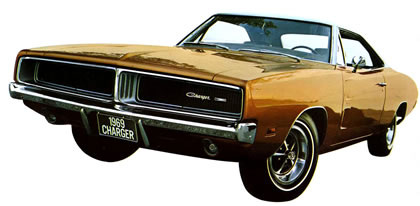 Who would have thought that when the 1969 Dodge Charger R/T debuted that it would sell 85,000 vehicles and make motor vehicle history? If you were into Dodge Chargers you knew something was just right about the 1969 but you couldn’t put your hand on it.
Who would have thought that when the 1969 Dodge Charger R/T debuted that it would sell 85,000 vehicles and make motor vehicle history? If you were into Dodge Chargers you knew something was just right about the 1969 but you couldn’t put your hand on it.
The design seemed balanced. It wasn’t overly conservative and it wasn’t overly chromed. It didn’t have hugely flared sides and it didn’t have all of the other design tricks that the masters of the 1969 design teams had up their sleeves.
Smooth Lines
The wind-cheating 1969 Charger – for that was what the design actually was, if you looked at it closely from the side – had a nicely rounded, dual oval front that was split in the middle by a bright piece. The blacked out grille worked well with the piece of bright trim work and it looked like a whole piece. You had to look again to see that just below the small bumper was a sweeping section that worked nicely with two real cooling scoops and the license surround.
From there the eye was drawn up to the clean lines and slightly raked hood and the very slightly ridged front fenders. If you then looked across the R/T you saw that the designers had included a very slight rounding that worked back to the A-pillar and front door. The lines seemed to culminate with the A-pillar until you looked again and saw that the design team had repeated the same ever-so-slight rounding through the rear quarter panels. The rear decklid was straight and the multi-oval bright rear just worked nicely so that the whole design was easily worth the $4,380.
The engines, although advertised as hemis, were not true hemis (hemispherical combustion chambers pioneered by Chrysler from 1951 to 58 and which must have made their appearance in the M series of the time) were really semi-hemis that enjoyed being used. Although the few “real hemis” made – about 500 – were advertised as having 425 horsepower and 490 pounds-feet of torque. Few Chargers sold in that configuration, though. More likely, the engine that was burbling under the hood was either the 375 horsepower engine and a deuce or a four-barrel 390-horsepower 440-cubic-inch.
Buyers had a choice of a four-speed standard, equipped with the Charger signal pistol-grip shifter, or a three-speed automatic and a console separating bucket seats. A special option that was continued for 1969 was the SE that offered buyers power steering, a sliding roof.
Flexible Powerplant
One thing to note about the Charger was the flexibility of its engine. Some commentators have mentioned that you could easily lug the engine down to a low rpm level and just sit, like a spider waiting patiently for an insect and that when you hit it, the engine spun up and lit up the 4.10:1 rear end, leaving other cars in the proverbial dust.
One last note, of the 500 or so real “hemis” offered, they were for racing purposes and were never really taxes that way. The “hemi” or hemispherical combustion chamber made its appearance in 1951 and made was for change in 1958. It was likely used in Chrysler’s performance car of the time, the M.
